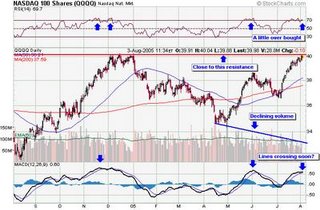Do you wish you could change your trading style to become more profitable, but by taking only low risks?
Do you wish you could trade more sensibly whereby you knew before hand the risk/reward trade off?
Do you wish that you had more leisure time to spend with your family or friends instead of worrying about your recent trades in the stock market?
Do you wish you could trade fewer times yet make a whole lot more money in the stock market?
Then read on…
In order to make money in the stock markets, you need to have BALANCE!
A fine balance between risk and reward that gives YOU the advantage.
A balance that gives you the means to achieve your profit GOALS.
Trading stocks without using Technical Analysis is like driving a car without a map. You will go wherever the road takes you, getting off and on randomly. You will certainly arrive some place, but probably not at your desired destination. Profitable QQQQ trading, for example, is possible if you follow a "method". We have advised hundreds of traders all over the world, including some of the richest people in the world. These traders are professional traders. A few of them own their private jets. They would not enter into a single deal without first checking what the technical indicators say. Why do you think they do this? They realize that no matter what their personal opinion is about the value of technical analysis, the market as a whole relies on this key factor. They know that ignoring chart points will cost them dearly. They know that with the help of technical analysis, they can enter into and out of trades at precise levels that allow them to control risk, and enables them to ride a good trade to its fullest potential. DO YOU WANT TO JOIN THEIR RANK? Then read on..
Let us first dispel some myths about trading in the stock market:
Myth Number 1:
"You have to trade many different stocks in order to make money, because you win in some and lose in some."
Nothing can be farther from the truth. Investing is different from trading. If you are an investor, then yes, you need to have a diversified portfolio to reduce your risks. Even then, you are only diversifying the so-called "systematic" or company-specific risk.
The truth about trading is this. What you need to make money is to concentrate, and gain experience in one or two instruments. That way, you would know the past behavior, and key levels that were significant. You can be profitable by trading just one stock, the QQQQ for example. Profitable trading of QQQQ is easier because it is a very liquid market.
Myth Number 2:
"It is easier to make money by buying dips and selling rallies."
Indeed, you will make money if you had bought the dip prior to the rally, and vice-versa. But consider what would happen if the market continues to go lower after you had bought a stock. When would you know you made an incorrect trading decision? Many traders see a stock declining by a few dollars and think it is time to buy because they have seen a dip. This approach could work some of the times, but most of the time one would end up losing.
Myth Number 3:
"If the economic news is good, it is time to buy."
This is a short cut to disaster. Professional traders often buy in anticipation of news, and when the news is actually out, they get out of that trade, exactly when the novice wants to buy!
Myth Number 4:
"Averaging a position is a good way to reduce your holding cost."
Sure, if you are an investor who is committed to a position, then averaging is a great way to be ahead. But if you are a trader, then you are in an entirely different ball game. You can't keep adding to a losing position and hope it will turn out to be ok in a few days. The question is when will I know if a trade is bad? Technical analysis will give you some good clues.
Myth Number 5:
"You have to be trading daily, or regularly to make money."
This is another big mistake. You don't have to be in the market all the time to make money. Trading should not be an obsession for you. You should be patient for the right level to get into a trade. Otherwise, you will end up trading your emotions. In these pages, CraftyStox will give you invaluable clues. In the examples you see in these pages you will learn about timing your trade in the market, how to place your stop-loss order and what your exit strategy should be. Thus, you will be able to assess if the risk-reward trade off is good for you. And the best news is that this intelligence is available for you for free.


